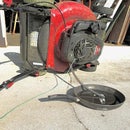Introduction: Solderless Electrical Connector
Many years ago when I was helping my father in his small electrical wiring business we often used what we called SE connectors. I suspect SE meant "solderless electrical" connectors. I cannot find them anywhere, but I have occasional temporary need for one or two. So, I made my own from steel. Those I remember were solid copper.
Materials
- 18 gauge sheet steel
- 10-24 screw (or M5 coarse thread)
- 10-24 nut (or M5 coarse thread)
- Motor oil
Tools
- Saw or shears
- Hammer
- Pliers
- Vise
- MIG welder
- Grinder
- 10-24 tap and tap wrench
The photo shows my SE connector in use. It nicely accommodates #10 wire or smaller. I want to connect wires together temporarily for testing wire pathways through walls with an Ohmmeter.
Step 1: Cut the Steel
I cut 18 gauge sheet steel to about 1/2 inch wide and 1 1/4 inches long.
Step 2: Bend the Steel
I found a piece of scrap steel almost identical in thickness to the diameter of the #10 screw I am using, which is about 3/16 inch. The first photo shows beginning to bend the steel into a "U" shape. The second photo shows my finished product. Ideally, the ends are equal. In practice that takes some attention and work to achieve. A quicker and easier way is to cut the steel longer than 1 1/4 inches and trim away any uneven ends with a saw or grinder.
Step 3: Prepare to Weld
The first photo shows the two pieces ready to weld together. In the second photo I have lifted the "U" shaped piece a little with six layers of masking tape. This is so the screw is more centered in the opening and less likely to bind on the internal sides of the "U" piece. I used a light tension spring clamp to hold the "U" shaped piece in place. The spring clamp also insures a ground connection for better welding. I will run a weld bead where the nut meets the 18 gauge steel. I left the screw in the nut for welding because I do not want to burn up the nut. The screw helps spread out the heat and protect the nut. I set the welder for 18 gauge steel. Even though the nut is thicker, it does not have much mass. The nut turned red hot, even though I kept welding time short.
Step 4: Chase Threads
I chased the treads with a tap in case the screw shifted during welding and in case the nut distorted from the heat. Notice the weld bead where the nut joins to the flat steel. Add a drop of motor oil to the threads for smooth action.
Step 5: Real World Use
When my father and I used SE connectors many years ago, we used them to join wires together. Then we taped the connectors and folded them into junction boxes. Wire nuts were just coming into widespread use at the time and may be what made SE connectors extinct.
The photo shows a real world use I have for my steel SE connectors. A friend has two three-way switches together with one 4-way switch in his shop. From the day he moved into this shop, the 3-way switches have never worked correctly. I unspooled about 80 feet of single strand plastic covered wire across the floor from one 3-way switch to the 4-way switch at the other end of the building. I used my SE connector to connect one of the travelers to the wire on the floor. At the other end I used an Ohmmeter to determine if there is continuity between the wire under test on both ends. I discovered the traveler is broken or not connected somewhere in the walls or ceiling. All other wires related to those switches show good connections and good continuity. Now we know what the problem is. We just do not know exactly where it is, yet.











